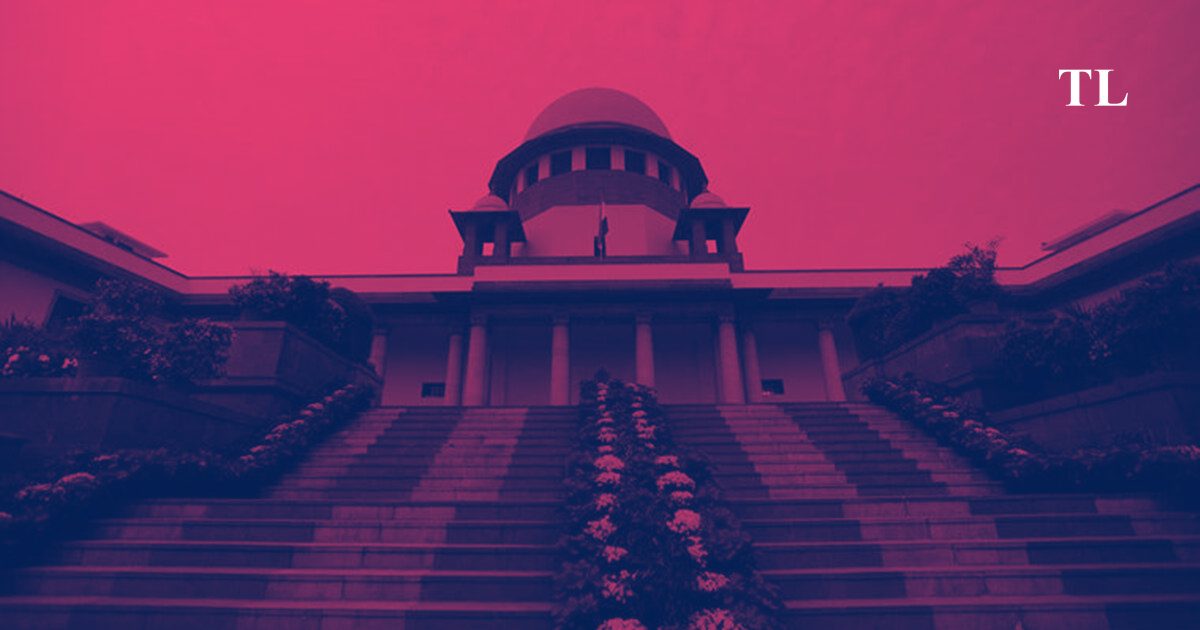The Supreme Court has limited the number of constitution benches, protested the number of unfilled vacancies, and tracked with serious interest the rate of institution and disposal of cases to reduce its case pendency. However, these approaches have not been particularly successful. NIHAL SAHU and KEYA REBELLO analyze recent data, particularly since the institution of virtual courts, and discuss various approaches to limiting pendency.
———-
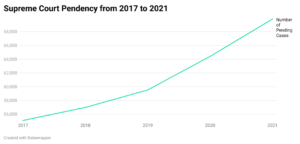


THE Supreme Court evidently regards the number of pending cases, which is now at a stratospheric seventy thousand, as a serious concern. Successive Chief Justices have expressed confidence in the face of pendency, with little success. Justice Ranjan Gogoi said, two days before he became Chief Justice, that pendency was “a serious problem, but it is not too difficult and can be resolved. I have a plan and will soon unfold it.” In the period between October 2018 and November 2019, during which Chief Justice Gogoi served as master of the roster, pendency increased from 55,946 to 59,867, a staggering 7 per cent increase in a single year. By the time he left office, Chief Justice Gogoi was far more combative about the criticism, saying that “[t]he Challenge that has been foisted at us, at all levels of the national discourse, is the topic of ‘pendency’. It is nothing more than a reckless use of that word … it is used for motivated onslaughts on our Institution and to pull us down.”
Like his predecessors, incumbent Chief Justice of India [CJI] N.V. Ramana is extremely keen on reducing pendency. On March 19, 2021, a month before he became the CJI, Justice Ramana suggested a “three-pronged action plan” for reducing pendency in the courts. This approach involved: establishing more courts and making them virtual where necessary, settling disputes without litigation, and strengthening the alternative dispute resolution [ADR] mechanism. Under his tenure so far, pendency has gone up by another 2,960 cases. To paraphrase the character of Sir Humphrey Appleby from the British television series Yes Minister, the data suggests that “things don’t happen just because [Chief Justices] are keen on them.”
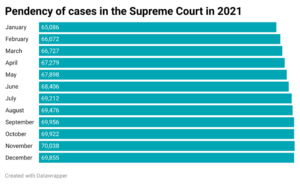


Also read: What does data on pendency of cases in Indian courts tell us?
A dash of empiricism
In 2014, academic Dr Sudhir Krishnaswamy, the present Vice-Chancellor of National Law School of India University, Bangalore, surveyed a predictable list of strategies to reduce pendency – increase the number of judges, create more courts, encourage ADR, resolve more cases through mediation, focus on Lok Adalats – and found them “unchanging and unimaginative.” He pointed out that “[I]ndian policymakers have over the years increased the supply of judges, diverted and dispersed cases to Alternative Dispute Resolution forums, special courts and tribunals with little or no improvement of the overall health of the legal system.”
The rate at which pendency increases or (rarely) decreases is a function of two variables: the number of cases instituted every year (the institution rate), and the number of the cases disposed of every year (the disposal rate). To say that pendency is climbing every year means that every year, more cases are being filed than the Court can hear and dispose of.
Evidently, the public debate around pendency needs a dash of empiricism. The Supreme Court has published pendency data every year since 2012, apart from 2015, and the only thing consistent about the data is that it is inconsistent, and stubbornly resistant to measures to reduce it.
The number of pending cases is a straightforward figure. The rate at which pendency increases or (rarely) decreases is a function of two variables: the number of cases instituted every year (the institution rate), and the number of the cases disposed of every year (the disposal rate). To say that pendency is climbing every year means that every year, more cases are being filed than the Court can hear and dispose of.
But the number of pending cases does not tell us very much. Critically, it does not tell us much about what causes increases in pendency or what would reduce it.
Also read: Why is the higher judiciary clogged with bail matters?
Getting to break even
The Supreme Court performs a number of functions, but two of them conflict quite heavily. First, it functions as a court of appeal, hearing an enormous number of appeals every year. In fact, most cases pending before the Court at any given time are admission matters, which have not been admitted for regular hearings yet. Second, it acts as a constitutional court, deciding important issues of law, and matters of public importance and constitutional significance. The decades since 1970 have seen the appeal function steadily cannibalise the judicial time of the Court, and the number of constitution bench judgments have gradually gone down to the astonishing number of three last year.
In 2019, pendency increased by 3 per cent between the start and the end of the year. In 2020, pendency increased at thrice that rate, standing at 9.07 per cent.
In 2019, academic Rahul Hemrajani and lawyer Himanshu Agarwal published a stellar paper pointing out that the number of pending cases is not a very useful metric, since “[s]ome cases may be disposed within seconds, while others may be heard for several hours.” They tracked display boards at the Supreme Court and came up with a time-based analysis of the Supreme Court’s workload. On this basis, they model how long it would take to reach a break-even point on pendency – where all pending cases will have been disposed of, and the Court will only have to hear incoming cases. And so, it is possible to empirically evaluate different approaches to pendency.
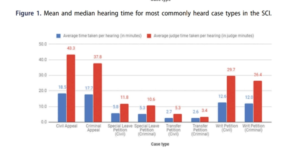


Filling vacancies is the most obvious step because the disposal of cases is directly proportional to the number of judges in the court. Hemrajani and Agarwal point out that if vacancies were filled and “31 judges work at actual efficiency, the court will break-even in 18 years.” As of now, the number of judges at the Supreme Court is 32, as against a sanctioned strength of 34.
But 2020 saw the emergence of a new threat to the administration of justice – Coronavirus. The judiciary was forced to transition into a virtual mode of hearing cases, bringing with it a new set of logistical hurdles and ultimately leading to a much higher rate of pendency. The Court suspended physical proceedings and restricted virtual hearings to extremely urgent matters. To provide a comparative, in 2019, pendency increased by 3 per cent between the start and the end of the year. In 2020, pendency increased at thrice that rate, standing at 9.07 per cent.
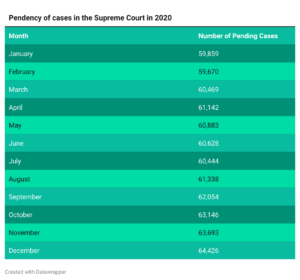


And even if we did not need to worry about future eventualities, the appointment of judges remains a persistent concern. Hemrajani and Agarwal have stated that “[s]ince vacancies in the SCI should be filled, for all suggestions after this, we assume that the court will work at full sanctioned strength.” This is, however, easier said than done. 2022 will be a particularly difficult year for two reasons: first, eight Supreme Court judges are due to retire this year; and second, the appointment of judges to the Supreme Court is a complex dance between the Executive and the Judiciary that can take a while. There are various entanglements, political interests, and individual concerns that can result in seats remaining unfilled and the Court operating below full capacity.
Blaming litigants working within a deeply imperfect system does not contribute to a realistic solution.
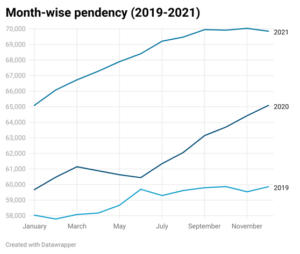


One strategy that could still work is reducing the number of days during which the Court is on vacation. In 2019, the number of pending cases increased steadily every month, with a big jump between April and June. The Supreme Court usually goes on summer vacation in May. This is a serious cause of pendency. Hemrajani and Agarwal point out that “[i]n 2016 for example, the court worked for 179 days and was on vacation for 61 days, excluding public holidays and weekends. Removing these court vacations while keeping public holidays and weekends intact, will reduce the time it will take to break even to 4 years.” Critics of the campaign to limit or eliminate court vacations argue that fatigue could impact efficiency. However, a subsequent analysis by Hemarajani suggests that this is not the case.
Special Leave Petitions [SLPs] are another sticking point. Legal scholar Tarunabh Khaitan has argued that “an expansive SLP docket has cannibalised the Court’s role as an effective constitutional court.” SLPs significantly impact the workload of the court, hamper judicial efficiency and are resource intensive. SLP admission rates could be reduced, and the points of appeal limited. However, Hemrajani and Agarwal also point out that dispensing with SLPs may not be an appropriate solution, especially given that the average time a judge spends on an SLP is quite low. Khaitan’s solution, which is to institutionally separate the appellate and constitutional functions of the Court, seems attractive.
Also read: Criminal Justice Reforms will Make Plea Bargaining Effective in Reducing Pendency of Cases
Conclusion
While there are many more proposed solutions to analyse, our principal point is this: discussions around pendency lack empiricism. From the Court’s annual reports to op-ed columns, we see a stunning lack of concern about finding realistic solutions.
The debate around pendency matters. We must keep the debate rigorous and analytical, if only so that we cannot seriously argue, as the Chief Justice did, that pendency is caused, among other things, by an “Indian phenomenon” called “luxurious litigation” wherein “parties with resources attempt to frustrate the judicial process and delay it by filing numerous proceedings across the judicial system.” Blaming litigants working within a deeply imperfect system does not contribute to a realistic solution.
Pendency imposes costs on a legal system and negatively affects the administration of justice. But it is only one of the things that imposes a cost. Courts are not just a service delivery mechanism.
And a single-minded focus on pendency can also be deeply harmful to the functioning of a republic. One approach that has been used over past years, for instance, is to limit the number of constitution benches, or more recently, to keep them pending. Since constitution benches take up the attention of at least five judges over an extended period, they seriously affect the ability of the Court to clear off the existing workload.
This is not abstract or academic. The JALDI project by the Vidhi Centre for Legal Policy tracks pending cases before five, seven, and nine-judge constitution benches of the Supreme Court, as on March 8, 2021. They include the nine-judge bench constituted to decide the reference from the Sabarimala Review, which is meant to address the entire body of law regarding how religious freedom cases are decided; the definition of “industry” under Section 2(j) of the Industrial Disputes Act, 1947; the conflict between legislative privileges and the freedom of the press; the classification of the Finance Act, 2017 as a Money Bill; the legality of Jallikattu; the appointment of election commissioners; EWS [Economically Weaker Sections] reservations; whether the Court can use Article 142 of the Constitution to dissolve marriages; and the compensation to be paid to victims of the Bhopal Gas Tragedy.
But that cannot possibly be a reason not to hear important constitutional issues. Pendency imposes costs on a legal system and negatively affects the administration of justice. But it is only one of the things that imposes a cost. Courts are not just a service delivery mechanism. They are sacred spaces where the most important issues of our time are argued and adjudicated.
To sum up, the way we argue about pendency is deeply flawed. The public debate either disregards empirical evidence or blames litigants, or uses pendency as a smokescreen to defend a failure to hear important constitutional matters. This is a multiple-system failure for which we are all responsible. We can begin to remedy this failure by holding the Court accountable and beginning a serious discussion about pendency.
(Nihal Sahu is an independent writer and researcher based in Kerala who writes a weekly newsletter at arguable.substack.com. Keya Rebello is an independent writer and researcher based in Bangalore working on issues surrounding criminal law and human rights. The views expressed are personal.)

